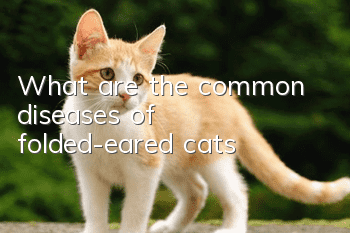What are the common diseases of folded-eared cats?

Fold-eared cats are loved by everyone for their cute and docile appearance. However, due to congenital genetic reasons, cats with folded ears are more likely to suffer from the disease, and the severity of symptoms and age of onset vary from cat to cat. It is inevitable that any pet will have common congenital diseases and physical defects. Cats are speechless and cannot seek medical treatment even if they are in pain. Therefore, parents who raise fold-eared cats must understand the relevant knowledge and pay more attention to them!
Don’t think that folded-eared cats are cute because they sit like humans. In fact, it is caused by stiffness of their hind limbs or pain when flexing. If this occurs, you need to be vigilant. Cats that have been infected will be inactive at first, and will have difficulty moving later. Obvious symptoms include:
1. The tail is thick, short, stiff and unable to bend. Some sick cats’ tails cannot swing.
2. The hind limbs are too short and have unusual bends, growths or lumps.
3. The joints of the limbs are swollen, and the toes are also deformed due to joint swelling.
4. The hind paws are abnormally thick. If you observe carefully, when the cat sits upright, the pillow meat of the hind paws cannot touch the ground.
5. The toenails grow abnormally and the pads will be thicker than those of normal cats.
6. Fold-eared cats will also have similar symptoms on their forelimbs, but the symptoms are milder than those on their hind limbs, and they will habitually lift their feet.
Other common diseases
In addition to hereditary bone diseases, fold-eared cats also have the following diseases that are common in them:
1. Respiratory system problems
In addition to affecting the bones of the hands and feet, the genes for bone disease can also affect the abnormal development of cartilage tissue in other parts of the body. The more common problem is that the respiratory tract is narrowed, causing difficulty in breathing. In severe cases, surgery is required to widen the respiratory tract. There is also the problem of nosebleeds, but the cause is currently unknown and there is no treatment.
2. Weak physique
There have been cases of cats whose body shape and weight were only two-thirds of normal cats. They were also infected with feline distemper, skin diseases, allergies and other diseases.
3.Heart disease
Cardiac hypertrophy is also common in cats with folded ears, but it is generally difficult to detect until symptoms appear. It is life-threatening, and cats need to control their diet and take medication for life.
- What are the four essential nutrients for cats?
- Are Ragdoll cats big cats?
- How do you think Garfield is pure or not?
- If your cat licks its fur excessively, prepare a WOWO hair removal cream!
- What will happen if a cat licks an externally dewormed cat?
- Kitten snores while sleeping
- Why does a cat lose its teeth?
- Can Ragdoll cats jump very high?
- It is very important to improve the bad habits training of Siamese cats. Siamese cat training methods!
- Can cats spray flower dew?



